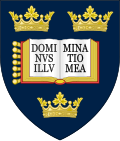T. de Mendonça (2019) M.P. Plotkowiak (2007, 2009) J.W. Scrogin (2004) D.B. Perkins (2002) Andrew Lindsay (1997, 1998, 1999) R. Blanda (1997) R.H. Manners (1993) S. Benham (1993) J.O.B. Sewall (1961) E.V. Vine (1954, 1955, 1956) E.C.B. Hammond (1953) W.J.H. Leckie (1949) W.W. Woodward (1948) John Cherry (1936, 1937, 1938) OUBC President S.R.C. Wood (1936) R.W. Holdsworth (1931, 1933, 1934) R.A.J. Poole (1931, 1932) C.M. Johnston (1930, 1931, 1932) J. de R. Kent (1932) G.M.L. Smith (1931) A. Graham (1929) OUBC President Sir J.H. Croft (1926, 1927, 1928) H.C. Morphett (1928, 1929) OUBC President G.H. Crawford (1926) G.J. Mower-White (1923, 1924, 1925) OUBC President W.P. Mellen (1923) P.R. Wace (1923) N. Field (1910) H.C. de J. du Vallon (1901) H.R.K. Pechell (1896, 1897, 1898) W. Burton Stewart (1894, 1895) J.A. Ford (1892, 1893) C.W. Kent (1891) F. Wilkinson (1891) W.F.C. Holland (1887, 1888 1889, 1890) H.R. Parker (1887, 1888, 1889) L. Frere (1888) F.J. Humphreys (1884, 1885) E.L. Puxley (1883) R.H.J. Poole (1880, 1881) H.P. Marriott (1875, 1876, 1877, 1878, 1879) T C Edwards-Moss (1875, 1876, 1877, 1878) J.P. Way (1874) H.W. Benson (1874) M.G. Farrer (1873) J.M. Clintock-Bunbury (1871) [23] F. Crowder (1866, 1867) [23] D. Pocklington (1864) [23] R. Shepherd (1863) W.B. Woodgate (1861, 1862) W. Champneys (1861) [23] H.F. Baxter (1859, 1860) [23] W. Houghton (1849, 1852) [23] R. Greenall (1852)OUBC President [23] K. Prescot (1852) [23] J.J. Hornby (1849) F.C. Royds (1847, 1848) OUBC President [23] G.R. Winter (1847, 1848) OUBC President [23] J. Oldham (1847) [23] F.E. Tuke (1845) OUBC President J.J. Somers-Cocks (1841) G. Meynell (1840,1841) W. Lea (1841) E. Royds (1840, 1841) W.B. Garnett (1840) [24] J.J. Somers-Cocks (1840) R.G. Walls (1839, 1840) | T. Watson (2011,2012) J.L. Carlson (Cox, 2010) E.P. Newman (2010) A.N. Keats (2005) T.H. Baker (2001) T.J. Whitaker (1993) K.W. Kobach (1991, 1992) E.M. Martin (1983, 1984) J.O.B. Sewall (1959, 1960) G.B. Hill (1948) D. Moffatt (1947) John Cherry (1935) | J.A Villanueva Moreno (2016) V. Stulgis (Cox, 2012) J.L. Carlson (Cox, 2011) M. Neve (2010) B. Bell (1998) D. Brocklebank (1997) J. Bailey (1995) D. Bridges (1995) R. Weeks (1994) D. Long (1990) D. Horner (1989) P. Drew (1988) W.G. O’Chee (1987) J. Hawkins (1986) J. Kirwan (1986) | T. Gunter (2012) H. Engel (2007) O. Gilmore (2002) D. Foster (1989) | S. Williams (1976) A. Brown (1981) C. Richens (1984, 1985) S. Shekleton (1986) C. Taylor (1986) A. Crawford (1987) A. Hadfield (1989, 1990, 1991) K. Cross (1990) S. Benham (1992) J. Leach (1992) M. Morris (1996) K. White (1996) N. Waddell (1998, 2000, 2001) J. Hebert (2017) | S. Sheckleton (1985) A. Bailes (1987) E. Taylor & A. Hadfield (1988) K. Cross (1989) K. Houghton (1990, 1991) J. Leach (1993) A.V. Manen (2003) K. Anderson & J. Allen (2019) | Dom Shields (1998) Roma Backhouse (1998) Sarah Phipps (1993) Karen Ball (1992) |







